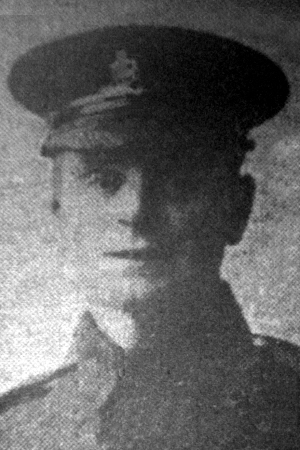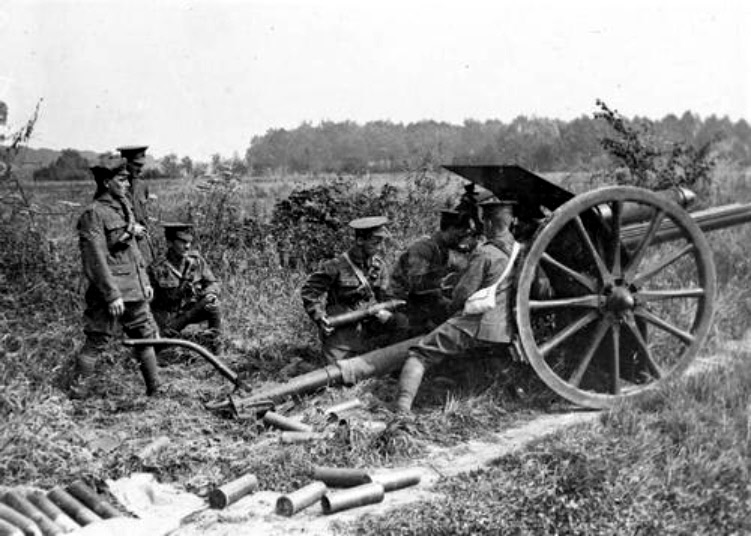
165263, Royal Field Artillery, 158th Brigade, 380th Battery
George Henry Taylor was born in Ossett in 1880, the eldest son of Suffolk born mason’s labourer John Taylor and his wife Frances (nee Cattley) who was born in Ardsley. The couple married at Wakefield in 1877.
In 1891, John and Frances Taylor and their four children, two boys and two girls, were living on Back Lane, Ossett and then, in 1901, on Moorcroft Street, Ossett when John Taylor earned his living as a brick maker and George was a teamster in a mill.
On the 27th July 1901, at Ossett Holy Trinity Church, 21 year-old George Henry Taylor married 18 year-old Laura Bennett of Townend, Ossett and in 1911 they were living at 12, Springstone Avenue, Ossett. George worked as a teamer in a woollen manufactory. They have no children.
George Taylor’s parents and two unmarried sisters are also living elsewhere on Springstone Avenue and his father, John, was church sexton.
The 158th brigade of the Royal Field Artillery was formed at Heytesbury, Wiltshire on the 13th April 1917 under Lt.-Col. H. E. Hanson DSO. Note that this was the second 158th Brigade RFA to be formed; the first, which was formed at Accrington and Burnley had already been disbanded by 1917.
Batteries under command were 2/1st Shropshire RHA, 2/1st Berkshire RHA, 380 Battery RFA and 381 Batter RFA. The Brigade Ammunition Column was found from men of the two RHA batteries. On the 7th May 1917, the brigade moved to West Down on Salisbury Plain for firing practice. The brigade sailed from Folkestone to Boulogne on the 24th May 1917 and moved, at first, to one of the camps at nearby St. Martin. Three days later, a move was made by rail to Bailleul. Here the 2/1st Shropshire RHA was temporarily placed under command of the New Zealand Division for instructional purposes; the Berkshire RHA went to 4th Division and the others to 25th Division.
In late March 1918, 158 Brigade, RFA, as part of 25 Division were involved in intensive action against the German Spring Offensive on the Somme. The defensive fight was continuous and confusing, as enemy units pushed forward on all sides. Carrying out a fighting withdrawal, by the 26 March, the Division found itself on the 1916 Somme battlefield. On that date, the Division was finally relieved and moved to Pommier and thence to Couin. By 28 March 1918, the Brigades were south of Doullens and out – for the moment – of harm’s way.
The Division was desperately tired, having been in continuous action and covering on 27th and 28th March a considerable distance on foot (36 miles in 36 hours). It had also lost more than half its fighting strength: 318 officers and men dead, 1496 wounded and 1588 missing, many taken prisoner. On the 30th and 31st March, the Division entrained and moved to Caestre. However, the Divisional artillery remained behind, supporting the New Zealand Division, until 7 April, the day that Bombardier George H. Taylor died from his wounds in hospital. Clearly, Bombardier Taylor had been involved in the bitter fighting and defensive withdrawal in late March, when he was mortally wounded in the shoulder.
The “Ossett Observer” 1 had this short tribute to George H. Taylor:
“Ossett Man’s Death From Wounds – Bombardier George Taylor (38), Royal Field Artillery, a married man, whose home was at Woodbine-street, Ossett, and who last week was reported to have been seriously wounded, died on Sunday from the effects of his injuries. He was well-known and in civilian life was a teamer.”
The report mentioned above for the previous week’s “Ossett Observer” also tells us that:
“George H. Taylor, a married man, whose home is in Woodbine-street, Ossett, and who has gone through a good deal of fighting in the war, has been severely wounded in the shoulder.”
Lance-Bombardier G.H. Taylor’s service record has not survived. His medal card records him as “Gunner” and he was awarded the British and Victory medals. He did not serve overseas before 31 December 1915 so did not qualify for the 1914/15 Star.

Above: 18lb Field Gun in action on the Western Front during WW1, like the ones operated by Bombardier George Henry Taylor in 1918
Lance-Bombardier George Henry Taylor died of wounds on the 7th April 1918, aged 38 years, during the German Spring Offensive of 1918, ‘Operation Michael’, and is buried at grave reference X. B. 1. at the Wimereux Communal Cemetery 1 Pas de Calais, France. Wimereux is a small town situated approximately 5 kilometres north of Boulogne.
Wimereux was the headquarters of the Queen Mary’s Army Auxiliary Corps during the First World War and in 1919 it became the General Headquarters of the British Army.
From October 1914 onwards, Boulogne and Wimereux formed an important hospital centre and until June 1918, the medical units at Wimereux used the communal cemetery for burials, the south-eastern half having been set aside for Commonwealth graves, although a few burial were also made among the civilian graves. By June 1918, this half of the cemetery was filled, and subsequent burials from the hospitals at Wimereux were made in the new military cemetery at Terlincthun.
Wimereux Communal Cemetery contains 2,847, Commonwealth burials of the First World War, two of them unidentified. Buried among them is Lt.-Col. John McCrae, author of the poem “In Flanders Fields.” There are also five French and a plot of 170 German war graves.
CWGC heastone photograph courtesy of Mark Smith
References:
1. “Ossett Observer”, April 27th 1918